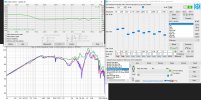Competetive_Radio
Member
- Joined
- Aug 13, 2023
- Messages
- 5
- Likes
- 3
This is my two cents about AKG K240 series.
Thing is they don't tolerate lack power (Sextetts, DF and early Monitors especially), forget phones, laptops, only with high end motherboards they begin to open, non Sextett type drivers (they lack six passive diaphragms) first thing that can barely drive them efficiently is Sound BlasterX G6, Mojo 2 is behaving little better but still can't handle Sextetts, DF and early Monitor well, Atom+ is when you don't need to fear for driving both non Sextett and Sextett type drivers. Whoever talk that can be driving by MP3 player is troller or have problem with listening and hearing.
Sextett Middle Production and Early Monitor have best sound quality but today they can be impossible to find and if you find them there is a chance that drivers are dead or condition is bad and you need to restore them. If you want to use K240 for listening music EQ is must and don't expect you to get ultimate headphone, they are many headphones that can outperform them like: DT-770/880/990,HD 598/9, HD-600/650, AKG K701/702/712, AKG K371, KSC75,... even K260 Professional (another AKG from bygone era) is better for music enjoyment then K240. Is K240 better than any "gaming headphones" the answer is yes, but gaming headphones is last thing on my mind when I compare headphones.
They pure purpose is monitoring nothing more nothing less, later K240 (still 600 ohm you will recognise them by white paper dampers) began to be much worse and avoid them even for monitoring (if you want to monitor anything more than casual talk and playing). K240 Studio is the same story, K240MK II tries to be more music listening (tunning bass and highs) but still would take Superlux HD-681/B and SR850 over MKII (both are cheaper and better).
This is my story I still love to collect them, if you disagree that's okay.
Thing is they don't tolerate lack power (Sextetts, DF and early Monitors especially), forget phones, laptops, only with high end motherboards they begin to open, non Sextett type drivers (they lack six passive diaphragms) first thing that can barely drive them efficiently is Sound BlasterX G6, Mojo 2 is behaving little better but still can't handle Sextetts, DF and early Monitor well, Atom+ is when you don't need to fear for driving both non Sextett and Sextett type drivers. Whoever talk that can be driving by MP3 player is troller or have problem with listening and hearing.
Sextett Middle Production and Early Monitor have best sound quality but today they can be impossible to find and if you find them there is a chance that drivers are dead or condition is bad and you need to restore them. If you want to use K240 for listening music EQ is must and don't expect you to get ultimate headphone, they are many headphones that can outperform them like: DT-770/880/990,HD 598/9, HD-600/650, AKG K701/702/712, AKG K371, KSC75,... even K260 Professional (another AKG from bygone era) is better for music enjoyment then K240. Is K240 better than any "gaming headphones" the answer is yes, but gaming headphones is last thing on my mind when I compare headphones.
They pure purpose is monitoring nothing more nothing less, later K240 (still 600 ohm you will recognise them by white paper dampers) began to be much worse and avoid them even for monitoring (if you want to monitor anything more than casual talk and playing). K240 Studio is the same story, K240MK II tries to be more music listening (tunning bass and highs) but still would take Superlux HD-681/B and SR850 over MKII (both are cheaper and better).
This is my story I still love to collect them, if you disagree that's okay.
Last edited:

